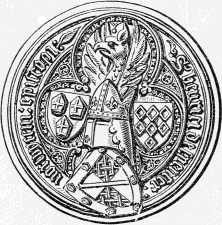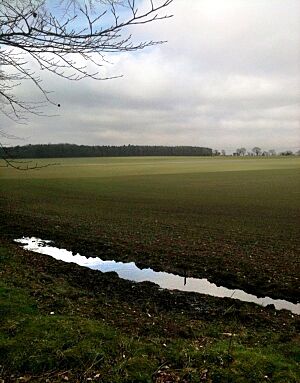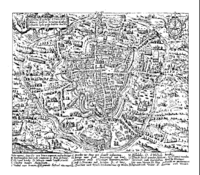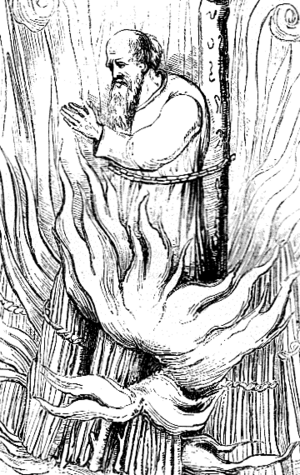Henry le Despenser facts for kids
Quick facts for kids Henry le Despenser |
|
|---|---|
| Bishop of Norwich | |

14th-century carving of Henry le Despenser, misericord in a chancel stall in King's Lynn Minster
|
|
| Enthroned | 12 July 1370 |
| Reign ended | 23 August 1406 |
| Predecessor | Thomas Percy |
| Successor | Alexander Tottington |
| Other posts | Archdeacon of Llandaff (around 1364–?) Canon of Salisbury (?–1370) |
| Orders | |
| Ordination | 17 December 1362 |
| Consecration | 20 April 1370 |
| Personal details | |
| Born | c. 1341 |
| Died | 23 August 1406 Elmham, Norfolk, England |
| Denomination | Roman Catholic |
| Parents | Edward le Despenser and Anne Ferrers |
| Alma mater | University of Oxford |
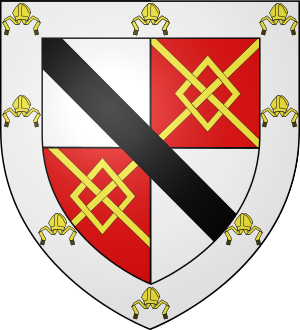
Henry le Despenser (born around 1341 – died August 23, 1406) was an English nobleman. He became the Bishop of Norwich. He was known as the 'Fighting Bishop'. He earned this name for stopping the Peasants' Revolt in East Anglia. He also defeated the rebels at the Battle of North Walsham in 1381.
As a young man, he studied at the University of Oxford. He held many important jobs in the English Church. He fought in Italy before becoming a bishop in 1370. In 1383, the English Parliament allowed Despenser to lead a special military campaign called a crusade. This crusade went to Flanders (modern-day Belgium). It was aimed at supporters of a rival pope, Clement VII. The crusade also protected England's trade and political interests.
Even though it had good funding, the expedition was not well-prepared. It also lacked strong military leaders. After some early wins, a difficult attempt to besiege the city of Ypres failed. This forced Despenser to return to England. When he came back, he faced charges in Parliament. King Richard II of England took away his church lands and income. However, these were given back to him in 1385. That same year, he joined the king on a trip north. They went to stop a possible French invasion of Scotland.
Despenser was a very active and capable leader. He strongly defended his church area against a religious group called Lollardy. In 1399, he supported King Richard II. This was after Henry Bolingbroke (who later became King Henry IV) landed in England. Despenser was arrested for not agreeing to terms with Bolingbroke. The next year, he was linked to a plot against the new king, called the Epiphany Rising. But he was later pardoned (forgiven).
Contents
Henry's Early Life and Family
Henry le Despenser was the youngest son of Edward le Despenser (1310–1342). His mother was Anne Ferrers (died 1367). Henry was born around 1342. This was the year his father died during a battle at Vannes. Henry and his three brothers all grew up to be soldiers.
His oldest brother, Edward Despenser, 1st Baron Despenser, was a famous knight. Henry and Edward fought together in Italy in 1369. They fought for Pope Urban V against the city of Milan. Henry's family, the le Despensers, came from France. His grandmother was Eleanor de Clare, who was a granddaughter of King Edward I of England.
Becoming a Bishop
In 1353, when he was about eleven, Henry became a canon (a type of priest) in Llandaff. A year later, he became a canon at Salisbury Cathedral. By age nineteen, he was a rector (head priest) in Bosworth. By 1361, he was studying law at the University of Oxford. He became a priest on December 17, 1362. By April 20, 1364, he was an archdeacon in Llandaff.
In 1370, the Pope appointed Despenser as the Bishop of Norwich. He was officially made a bishop in Rome on April 20. He then returned to England. He took control of his church duties in July 1370. He received his church lands from the king in August.
Stopping the Peasants' Revolt
In 1381, a major uprising called the Peasants' Revolt happened in England. Rebels from Kent and Essex marched to London. They captured the Tower of London. King Richard II met the rebels and promised to agree to their demands. But their leader, Wat Tyler, was killed, and the rebellion in London ended. The king then took back his promises.
The rebellion quickly spread to other parts of England, including Despenser's area, Norwich. On June 14, rebels reached Thetford. From there, the uprising spread across Norfolk. At the same time, other rebels, led by Geoffrey Litster, caused trouble in the northeast. Over the next few days, rebels gathered in Norwich, Lynn, and Swaffham.
Norwich was a very important city. Litster and his followers took it over. They damaged property and possessions of their enemies. Rebels also went to Yarmouth. They destroyed legal records and landowners' documents. There was much looting and demands for money across the county.
Despenser heard about the revolt while he was away from Norwich. He quickly rode back to Norfolk. He had only a small group of soldiers with him at first. But more people joined him along the way. By the time he reached North Walsham, he had a strong force. There, he found the rebels dug in behind temporary defenses.
According to a writer named Thomas Walsingham, Henry le Despenser himself led the attack. He fought hand-to-hand against the rebels. Many peasants were killed or captured. Their leader, Geoffrey Litster, was captured. Despenser personally oversaw Litster's execution. In the months that followed, Despenser dealt with other rebels in his area.
His harsh actions made him very unpopular in Norfolk. The next year, a plot was made to murder him. But one of the plotters revealed the plan. The authorities then dealt with those involved. After successfully stopping the rebellion, Despenser ordered a special artwork called a reredos. It was placed on the altar in Norwich Cathedral. This artwork showed scenes from Christ's last days. Despenser may have wanted to remind people to accept their place in life, just as Christ did.
The Norwich Crusade of 1383
In 1378, a big problem called the Western Schism started in the Church. Two men claimed to be the true Pope. One was Urban VI, and the other was Clement VII. This caused a lot of conflict across Europe. It was finally fixed much later, in 1418.
In 1382, Flanders (a region in modern-day Belgium) was invaded by the French king, Charles VI of France. The French forced the towns they conquered to support Clement VII. In response, Pope Urban VI called for a crusade. He chose Bishop Despenser to lead this campaign against Clement VII's supporters in Flanders. The Pope gave Despenser special powers for this mission. He also promised forgiveness for sins to those who joined or supported the crusade.
Both the common people and King Richard II were excited about the crusade. It had political and economic benefits for England. English wool trade with Flanders could restart. Also, sending the bishop instead of the king or his uncles meant that unpopular plans for a royal crusade to Spain could be dropped. French forces would also be drawn away from Spain. And relations between England and Flanders would get stronger. Another benefit was that the Church would pay for the crusade, not the government. The government was afraid to raise new taxes after the Peasants' Revolt.
On December 6, 1382, King Richard ordered the crusade to be announced across England. Later that month, Despenser and his men took a special vow at St. Paul's Cathedral. In February 1383, Parliament agreed to give Despenser money for the war in Flanders. The king only asked that the crusaders wait for William Beauchamp before attacking.
The bishop and archbishop ordered the Pope's message to be spread. Many people, especially "rich ladies of England," gave large amounts of money. The English landed in Calais in May 1383. They attacked Gravelines, which was held by the French. Gravelines, Dunkirk, and nearby towns quickly fell. On May 25, the crusaders defeated a French-Flemish army near Dunkirk. Despenser was then convinced by his followers to besiege Ypres. This proved to be the turning point of the crusade. He did not want to attack the city, but his allies insisted.
The people of Ypres were well-prepared for a siege. They had strengthened their defenses. They also sent for more artillery supplies from Paris. The city was well-organized for defense. The English attacked on the first day but were pushed back. For the next three days, they attacked the city gates without success. After a week, more soldiers arrived to surround the city.
On the eighth day, Despenser attacked with artillery. He damaged a gate but not enough to break through. Over the next days, constant artillery attacks had little effect. Despenser's troops were always beaten back. An attempt to drain the ditches around the city failed. Meanwhile, the people inside Ypres managed to get a message to the Duke of Burgundy. He raised a large French army to help the city. On August 8, after eight weeks, Despenser suddenly decided to give up the siege. He left his allies to continue on their own.
After the failure at Ypres, Despenser's forces split up. Some went back to England. Some stayed with the bishop. Others went to Bourbourg and Bergues. The bishop wanted to advance into France. But some of his commanders refused. The bishop had to fall back to Gravelines. The French army, led by the young King Charles, was strong. On August 8, after eight weeks of effort, Despenser decided to abandon the siege. By the end of October, the remaining crusaders had returned to England.
After the Crusade
Soon after returning from Flanders, the bishop faced charges in Parliament. This happened on October 26, 1383. The chancellor, Michael de la Pole, accused him of several things. These included not gathering enough troops and not allowing a military leader to command the expedition. Despenser denied all the charges. He said he had enough men and chose his commanders well. But his arguments were rejected. He was blamed for the crusade's failure. His church lands and income were taken away. He was also ordered to repay money gained from the French.
Despenser's troubles did not last long. After Scottish attacks on England, King Richard II, who was 18, decided to lead an army into Scotland. This was the start of his military career. The English army reached Edinburgh and looted it. Then they returned to England. This Scottish campaign was one of the last times Despenser marched with an army.
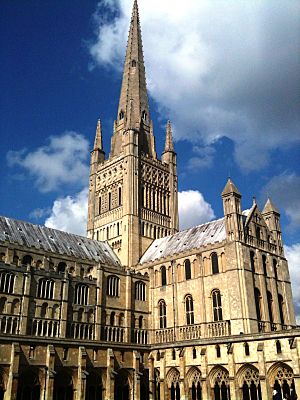
Henry le Despenser remained a strong figure even after his fighting career ended. He was known for his firm methods. He wanted to keep control over the people in his church area. He also strongly defended the traditional teachings of the church against Lollardy.
For over ten years, Despenser had arguments with the Norwich Cathedral chapter. He also had disputes with other religious groups in his area. These were mainly about his right to get involved in their internal matters. In 1394, the monks successfully appealed to Pope Boniface IX against Despenser. But the issues were not solved. In 1398, a royal group decided in favor of Despenser. However, the Pope later canceled these decisions. Eventually, the monks came to an agreement with the bishop. They accepted less control over their own affairs.
Fighting Lollardy
Since 1381, there was a growing fear of Lollardy among England's leaders. The Lollards were a religious group who appeared in the 1370s. At first, some upper-class people liked them. But by 1382, authorities could arrest people who were considered heretics (those with beliefs against official church teachings). King Richard II became more determined to keep traditional religious beliefs. He acted more harshly against the Lollards. His successor, Henry IV, went even further. He made it a crime punishable by death to be a heretic or to own a Bible not approved by the church.
Despenser took strong actions to maintain traditional beliefs in his own area. However, Henry did not seem to treat heretics too cruelly. On May 1, 1399, William Sawtrey, a Lollard priest from Norfolk, was questioned by Despenser. Sawtrey publicly took back his different beliefs. He apparently received no serious punishment from Despenser. But Sawtrey later moved to London. His preaching there caught the attention of Archbishop Thomas Arundel. Sawtrey was called to appear before a church meeting. Despenser did not attend but sent a written note. After his trial, Sawtrey was condemned as a heretic who had gone back to his old beliefs. He was burned at Smithfield in 1401.
Later Years and Death
When John of Gaunt died in February 1399, his son Henry became the Duke of Lancaster. But King Richard II quickly took away his family lands. Henry Bolingbroke decided to return to England from Paris. He wanted to reclaim his family's property. In July 1399, he landed in England. Henry le Despenser remained loyal to King Richard. He appointed others to take his place while he was away. By July 10, he had reached St. Albans with soldiers to help the Duke of York's army.
Despenser was with the Duke of York at Berkeley Castle. York made terms with Bolingbroke. But the bishop refused to give in. He was arrested and briefly put in prison. On September 30, Bolingbroke was declared king in London. Despenser may have seen this event. The bishop attended the new king's first Parliament on October 6, 1399. In this meeting, it was agreed that King Richard should be imprisoned. After this time, Despenser's power in his church area seemed to lessen.
Henry was involved in a failed plot in January 1400, called the Epiphany Rising. His nephew, Thomas, played a key part and was later executed. Thomas had lost his title after being accused of involvement in a death. He joined a conspiracy of other noblemen. Their army was attacked by townsmen. Thomas fled but was forced to go to Bristol. There, he was released to a crowd and beheaded.
After the rebellion, Henry le Despenser appointed a new vicar-general. He then put himself under the care of Archbishop Arundel. His enemy, Sir Thomas Erpingham, falsely accused him of being involved in the plot. He was finally forgiven by King Henry IV in 1401.
Despenser died on August 23, 1406. He was buried in Norwich Cathedral in front of the main altar. A special metal plate was placed there to remember him, but it has since been destroyed.
Images for kids


